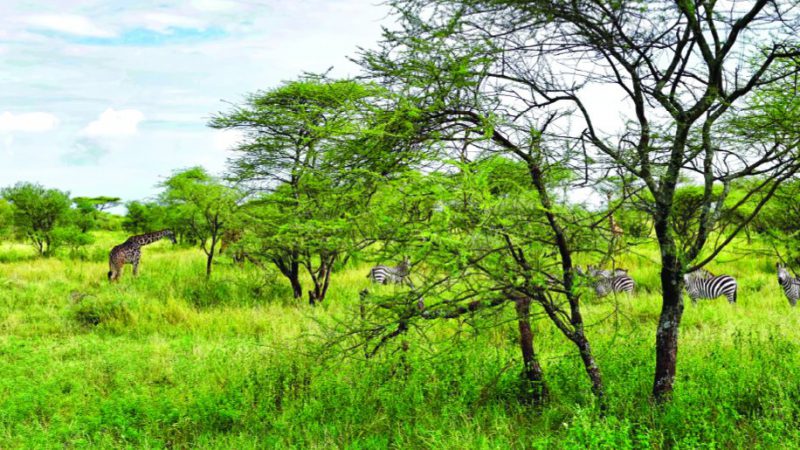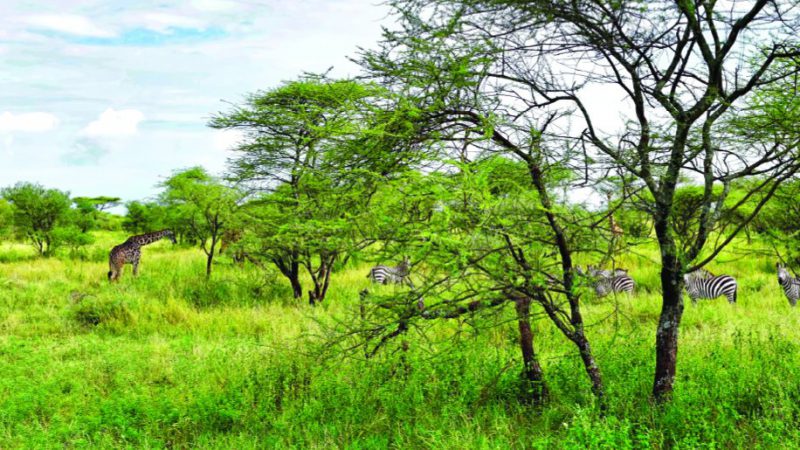Green Dreams in Tanzania
Tucked away on the east coast of the African continent is a land steeped in natural wonders
February 28, 2020


Africa has its own seasons. From November to April, while American and European families are donning winter coats and pushing through winter’s wrath, the great plains of the Serengeti are springing to life with fresh green growth on hardy acacias and lofty crotons and flaming red blooms on ubiquitous tulip trees.
This is called “the Green Season,” and it contrasts from Africa’s peak safari season, from July to September, in some dramatic ways – making it Africa’s “Secret Season” for the wealth of rare natural treasure to be discovered.
Tanzania is a land of Edens within this drama, bringing the wildlife spectacles to be found at Ngorongoro Crater and Serengeti National Park in the north as well as the Ruaha and Selous Game Reserves in the south. Lake Manyara, with scenery Ernest Hemingway called “the loveliest I had seen in Africa” remains as it was – a frame of exploding pinks against blinding blotches black stripes as flamingoes nest, herons light and zebra, wildebeest and giraffes cool off in the equatorial sun. Mt. Kilimanjaro looms in the distance on a clear day as the highest (19,341-foot) mountain on the continent and the tallest free-standing mountain in the world.
All of this is within reach of Arusha, fast becoming one of the top MICE locations in Africa. The Arusha International Conference Centre is a spectacular custom-built facility with the capacity to host up to 10,000 delegates.
“We are steadily preparing the country for the big time when it comes to business tourism,” says Arusha ICC CEO Elishilia D. Kaaya in an interview with AfricaLive.net. “Arusha is home to some of the most acclaimed natural sites in the world and our center is closely associated with these amazing sites because of our proximity to them. We want people to think about these wonders of the world whenever the Arusha International Conference Centre is mentioned.”
The development of the industry in Tanzania will see continued investment in infrastructure and facilities with new conference centers developing close to the country’s main tourist and business hubs such as Zanzibar and Dar es Salaam.
For those who want to mix meetings with a magical immersion in Tanzania’s natural beauty, there is no shortage of luxury safaris that can fill the bill. Top names familiar to US travelers include Micato Safaris, African Travel, Collette, Globus, Gate One, Goway, SITA, Intrepid, Tauck, Travcoa and many more. They manage group travel, private travel, super luxury travel, even jet safaris. Choices come into play for level of luxury and lodging rather than animal sightings. In Tanzania, Big Five conquests come with the territory.
It’s worth noting that the Trump administration made headlines recently with proposed new travel bans for six countries, including Tanzania. However as of this writing, the bans have not yet been officially put in effect, and only apply to certain visas for travel inbound to the US. And as always, before traveling it’s best to check with the State Department for any details about travel documentation.
Select Experiences
Access to Tanzania has been boosted in recent years by the return of national carrier Air Tanzania in 2016, which was able to establish direct flights from Uganda, Zambia, Zimbabwe and South Africa. Travelers can now fly easily into air fields near Kilimanjaro and the other three national park zones as well as Zanzibar – the Spice Islands, all well worth the exploration.
If Tanzania were to delve into the top five reasons to visit, it might look something like this:
•Wildlife Safaris: The great migrations, Ngorongoro Crater National Park that is home to the largest volcanic crater on earth with the largest concentration of varied wildlife to be found on the planet – and all this comes with the comforts and luxuries of five-star travel.
•Beaches: The soft sand littorals along the rims of Zanzibar and Pemba are laced with luxury lairs that open to the warm Indian Ocean, just a stone’s throw from the medieval alleys of Stonetown where century-old giant roaming tortoises blend with aromatic cafes and notion shops.
•Mountain Climbing: While conquering the highest mountain in Africa is always on the list, smaller mountains such as Mountain Meru and Lake Natron’s The Mountain of God also beckon.
•Balloon Safaris: Gliding over the Serengeti at sunrise? Bucket list.
•Exotic Foods: Dishes in Tanzania take on a piquant blend of Middle Eastern, Indian and Sub-Sahara. A little ugali, some curried fish, some local nuts and fruits and a lot of spices. Get used to the scent of cloves in Zanzibar.
Top Resorts in Tanzania
Tanzania has been in the resort business for some 80 years as royals and celebrities found Africa’s wilds to be a regular interest, if not an addiction. These range from comfortable permanent tented camps with decked out quarters that include attached bathrooms, hot baths, libraries, even Internet, all on a remote scape where lions roar and elephants make occasional entrances.
Four Seasons Safari Lodge Serengeti
Find this gem in Serengeti National Park. Quarters feature African décor and modern amenities such as a flat-screen TV, minibar, safe and air conditioning. Daily safaris, elaborate meals and a dipping overlooking the savannah are some of this lodge’s favorite features.
Singita Faru Faru Lodge
Find the newly refurbished Singita Faru Faru Lodge in northern Tanzania, within the Serengeti Mara ecosystem. The lodge is part of Singita’s 350,000-acre of private reserve and comes with spacious bedroom suites of contemporary African décor and design. The lodge sits on the scenic Grumeti River.
andBeyond Lake Manyara Tree Lodge
andBeyond Lake Manyara Tree Lodge offers nine romantic stilted treehouse suites shaded by a mahogany canopy and created to be a minimal imprint in this pristine setting on the environment.
Neptune Ngorongoro Luxury Lodge
This spread offers a wood log cabin-style retreat set within the virgin Tanzanian bush. It is walking distance to the Game Reserve Gate, and a 20-minute drive away from the Ngorongoro Crater, where the densest concentration of wildlife in Africa roam. The lodge brings 20 spacious private cabins complete with a fire place, as well as a restaurant, bar and conference facilities. The lodge is not far from Gibbs Farm, which overlooks the Great Rift Valley and invites guests to stay, explore, dine, spa and play. The farm was established in the early 1900s by a German Duke as a coffee plantation, but the Gibbs bought the farm after World War II and founded the oldest guesthouse in northern Tanzania.
1 on 1
A Rising Star in Tanzania
In 2019 Elizabeth Mwakajila Ayo was named one of three winners of the Tourism Star Award at the World Tourism Forum Lucerne. She is founder of Elizabeth Women Empowerment Foundation, which supports training women as professional tour guides in Tanzania’s tourism industry.
BT: Explain a little about why tourism is so important in Tanzania.
ELIZABETH: Tanzania’s tourism sector is booming with more than 1.5 million visitors a year contributing over $2.4 billion to our GDP, or about 17.5 percent. Our many tourism destinations include 22 national parks, like Burigi-Chato the new park which our president recently opened. We have Ngorongoro Crater and Kilimanjaro. And no one can forget our beautiful beaches on Zanzibar island.
BT: Why is this female safari guide project important for the country and the women of Tanzania?
ELIZABETH: Participation of women in Tanzania’s tourism sector – in particular as tour guides – is very low. Supporting women to participate as tour guides has several different advantages, including empowering young women and enhancing equal opportunities in the tourism sector. Further, having female tour guides enables tour operators to meet the needs of women travelers who prefer a female guide. It can be embarrassing for a tour operator when clients are looking for a qualified female guide and there is not one available. It is clear that women safari guides are in demand and can make a big impact.
BT: What inspired you to establish the Elizabeth Women Empowerment Foundation?
ELIZABETH: I realized that we need to make sure these young girls who live adjacent to the national parks are empowered so they can reach their full potential and rise above the poverty line. So I identified this as one of the projects that will bring the biggest impact. By giving these girls this special training and being safari guides, this will enable them to change their community economically. And these girls will be the best ambassadors of sustainable tourism for Tanzania, and for the whole world. They see the benefit of caring for natural resources, especially the animals, because these girls understand that this is the reason tourists visit our country, and when tourists visit they help raise our GDP.
BT: How will these women fit into the role of tour guide?
ELIZABETH: Similar to other sectors, traditionally the tourism sector is dominated by men. Tour guiding in particular has been considered limited to men, because of the demanding experiences out on the roads and in the wilderness. But in practice, women are capable of doing everything that men can do in the tourism sector, including managing tours and leading activities such as trekking, hiking and mountain climbing. More importantly, women are equally passionate about wildlife, conservation and tourism. Being connected to their traditional settings, women tour guides can describe their culture, history and religion, as well as local geography, topography, flora and fauna, and other natural features found in their environment. Female guides can even be more interesting to passengers by sharing personal stories of their families and their struggles to become a tour guide.
BT: What role will the Elizabeth Women Empowerment Foundation play in growing the number of women tour guides?
ELIZABETH: The project aims to support determined young female pioneers from indigenous communities in their quest to become tour guides. Since the tourism sector involves dealing with people from different countries and cultures, professionalism is very important. Therefore, this project initially intends to support 20 female tour guides per year from the local communities to undertake training that will enable them to become professional tour guides.
BT: Tell us about the support you’ve received for the program.
ELIZABETH: When I won Tourism Star Award at the World Tourism Forum Lucerne, I met Mr. Rob Gurney, the CEO of the Oneworld alliance. He was very supportive when he heard about our initiative to raise girls in Tanzania to work in the tourism and travel industry. Rob invited me to New York to see how he and the Oneworld team members could support the foundation. I am so very grateful for the connections we made through Rob and I hope to see many CEOs like him support us.The cost is $6,000 per girl per year. This will support these guides as they receive training in attitudinal changes – to create positive attitude towards their careers – enhance their communication skills, and give them basic knowledge about tourism and current affairs. Among the immediate project outcomes will be challenging the status quo and facilitating women to overcome the hurdles to claim a role in the tourism sector equal to men. But mostly, to cut the poverty line. They will be able to support their families financially and in health and education.
BT: What do you see as the end goal for these women?
ELIZABETH: We are expecting these female guides to be able to open their own tour companies, and to employ other women and change the community. Travelers will enjoy so much meeting the women guides who run these companies. And these women will do it with great success.Editor Note: For details on supporting the Elizabeth Women Empowerment Foundation, contact Elizabeth Mwakajila Ayo at elizabethmwakajila@gmail.com




